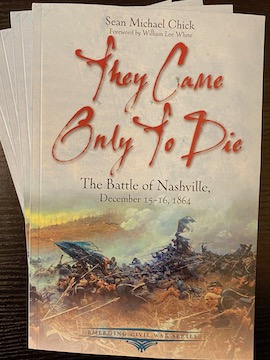Now Available from the Emerging Civil War Series: They Came Only to Die
 When people think of the battle of Franklin, they tend to recognize it as “the death ride of the Army of Tennessee” (to use a phrase from our Great Polish Colleague, Chris Kolakowski). But John Bell Hood’s battered army continued northward on its Quixotic quest to disrupt the Federal war effort in Tennessee, showing up on the doorstep of the state capital in mid-December. Their efforts proved futile, and as the title of Sean Chick’s new ECWS book suggests, Confederates “came only to die.”
When people think of the battle of Franklin, they tend to recognize it as “the death ride of the Army of Tennessee” (to use a phrase from our Great Polish Colleague, Chris Kolakowski). But John Bell Hood’s battered army continued northward on its Quixotic quest to disrupt the Federal war effort in Tennessee, showing up on the doorstep of the state capital in mid-December. Their efforts proved futile, and as the title of Sean Chick’s new ECWS book suggests, Confederates “came only to die.”
They Came Only to Die: The Battle of Nashville, December 15-16, 1864, is the latest book in the Emerging Civil War Series. It’s hot off the press, available now from Savas Beatie.
“I wanted to write about Nashville because I thought I had an ancestor there on the Union side,” Sean reveals. “I did not, but I found an interesting and sad story in this forgotten although important battle. It was a key reason the Confederacy collapsed only months later, and it showed that most Civil War battles were indecisive due to a lack of cavalry trained for intensive combat and pursuit. George Thomas had both, and so he won a battle as decisive as anything Napoleon ever won.”
The book features eight maps by Hal Jespersen, a foreword by Lee White (who wrote our Franklin book for the ECWS, Let us Die Like Men), and appendices by Ross Massey, Joe Ricci, Mark Wahlgren Summers, and Frank Varney. The cover features a beautiful full-color painting The Battle of Nashville by Howard Pyle courtesy of the Minnesota Historical Society. Pyle’s painting shows the attack of the 5th and 9th Minnesota Infantry near Shy’s Hill on December 16, 1864.
Remnants of the Army of Tennessee fought against Sherman in the North Carolina campaign and Canby at Mobile. The rumours of its “absolutely, positively, no doubt about it” demise were always premature, even if it had been brutalized and shattered. No other Army on either side took such abuse. And maintained some integrity.
But DID it maintain its integrity? Its shattered pieces were scattered across the South, and while many brigades did go on to perform solid service elsewhere, the army as it once existed was never really a viable concern. By the time JEJ returned to command, he had to cobble together a real hodge-podge of commands.
The remnants kept on fighting, and were the core of Johnston’s army in North Carolina and the Mobile garrison. But as a coherent fighting force that could mount an offensive or hold territory, it was gone. And really, even when it is stronger and more confidant, it was not all that good at retaking or holding territory, through no fault of the men in the ranks.
Having read “Let Us Die Like Men,” just at reading the words, “They Came Only to Die,” I knew this was the expected book about Nashville. It is now in line on the reading list, may pick it up at the Symposium.